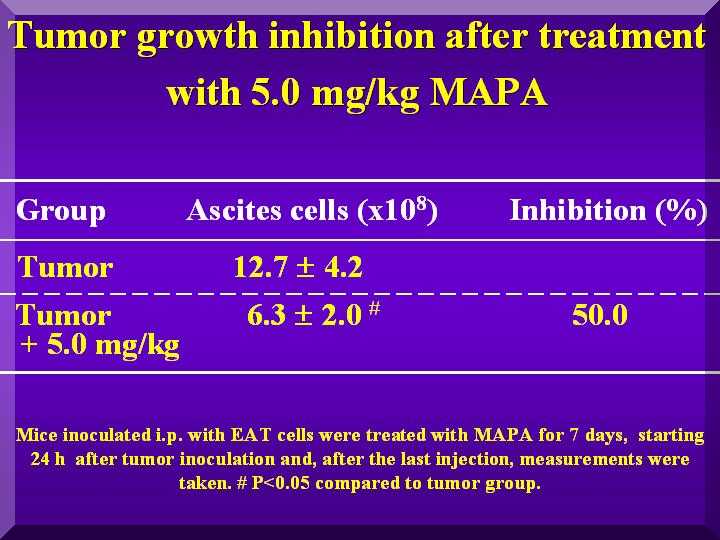

 Home |
Site Map |
Add to Favorites Link |
Send page to a Friend |
Contact us
Home |
Site Map |
Add to Favorites Link |
Send page to a Friend |
Contact us

|

 Home |
Site Map |
Add to Favorites Link |
Send page to a Friend |
Contact us
Home |
Site Map |
Add to Favorites Link |
Send page to a Friend |
Contact us
|
| About Us | Products | Research and Development | Publications and Press | Clinical Trials | Latest News | Contact us |
 |

10/07/2008
• P-MAPA - Effect on NK activity, lymphocyte proliferation and cytokine profile in Ehrlich ascites tumor-bearing mice
• P-MAPA - Effect on restoration of cell immunocompetence
Introduction
The growth of tumors is accompanied by changes in cellular constitution of the immune system.
Depletion of hematopoietic progenitors or hematopoiesis inhibition in human and animal tumor systems can result in an increase in the tumor growth rate.
• Background : Use of P-MAPA in Ehrlich tumor and other animal models
Since the response of bone marrow cells to hematopoietic growth factors is part of the immune response, an investigation was done on the effects of P- MAPA on the growth and differentiation of colony-forming units of granulocytes/macrophages (CFU-GM) of healthy and Ehrlich ascites tumor bearing mice (EAT) (Justo et al., 2000).
In a previous experiment, myelosuppression and increase of the number of (CFU-GM) were observed in the spleen of control animals bearing Ehrlich ascites tumor.
Subcutaneous (s.c.) administration of the biologically optimal active dosis of P-MAPA (5.0 mg/kg), for 7 days before (Figure 1) or after tumor inoculation increased the number of CFU-GM in the bone marrow, or in another words, led to a dose-dependent myelopoiesis stimulation. (Figure 2).
Figure 1

Figure 2

This was achieved without increasing the number of cells or subpopulation composition, i.e., without producing any imbalance.
The same dosage also stimulated myelopoiesis in the bone marrow of normal animals. (Figure 3)
Figure 3

The compound did not affect CFU-GM numbers in the spleen of normal animals, although it did reduce colony formation in the spleen of tumor -bearing animals.
Administration of 5.0 mg/kg of P-MAPA after tumor inoculation doubled the survival of EAT bearing animals (Figure 4) and reduced by about 50% the number of tumoral cells in the peritoneal cavity (Figure 5).
Figure 4

Figure 5

These results suggest that the myelopoietic response modulating effect of P- MAPA is related to its antitumoral activity, possibly through a mechanism of regulation of granulocyte/macrophage production and expression of their functional activities (Justo et al., 2000).
* Immunomodulating and biological effects of Ehrlich ascites tumor on experimental animals
In EAT bearing mice, total NK cell activity and spleen cell proliferation diminished to subnormal levels, as described in the literature (Parhar and Lala, 1985).
In addition to spleen growth and increase of total cell number in the organ, an increase in IL-10 level, a reduction of IL-2 level, and the maintenance of IL-4 and interferon-g (IFN-g) levels also occur (Parhar and Lala, 1988; Subiza et al., 1989; ViÏuela et al., 1991; Ruiz de Morales et al., 1999; Segura et al., 2000; Justo et al., 2003).
These findings are in line with studies showing that a correlation between the increase in splenic granulocyte-macrophage progenitor cells and the tumor mass exists in this tumor system, and that this phenomenon is closely associated with humoral factors of tumor origin and with the development of suppressor cells .
In view of these properties and the background, the effects of P-MAPA were studied on:
(1) proliferation of spleen cells induced by concanavalin A;
(2) cytokine production;
(3) activity of natural killer (NK) cells of Ehrlich ascites tumor bearing mice.
The results are presented below.
P-MAPA - Effect on NK activity, lymphocyte proliferation and cytokine profile in Ehrlich ascites tumor bearing mice (EAT)
1 - Treatment of mice with P-MAPA (5.0 mg/kg) for 7 days promoted reduction of tumor growth, proliferation of spleen cells, and a significant increase in NK cell activity. (Figure 6)
Figure 6
2 - In addition, it increased IFN-g level and IL-2 production, reduced IL-10 production relative to non-treated animals, increased the number of CFU-GM in the bone marrow, reduced splenomegaly by 35%, and reestablished a normal number of cells in the organ (Justo et al., 2003)
3- A significant reduction of tumor growth was also observed, resulting in an increase in survival, by means or immunotherapeutic mechanisms mediated or influenced by these substances.
Conclusions
• These experimental findings indicate that P-MAPA potentializes the immune mechanisms regulating marrow bone precursor cells, which are involved in controlling the changes caused by the tumor in the hosts hemolymphopoietic system.
• These results encourage us to consider possible therapeutic approaches combining P-MAPA with chemotherapeuticals to protect the host against their hematotoxicity and supplement their tumoricidal efficiency.
• Results obtained in these experiments are particularly relevant in that they indicate a restoration of cell immunocompetence in the organism undergoing a neoplasic process, due to a direct or indirect immunomodulating effect of P-MAPA.


|